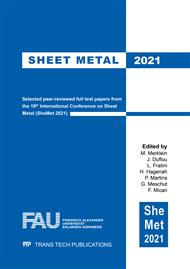[1]
K. Martinsen, S.J. Hu, B.E. Carlson, Joining of dissimilar materials, CIRP Ann. Manuf. Technol. 64 (2015) 679-699.
DOI: 10.1016/j.cirp.2015.05.006
Google Scholar
[2]
D.H.D. Eggink and M.W. Groll, Joining element design and product variety in manufacturing industries, Procedia CIRP 88 (2020) 76-81.
DOI: 10.1016/j.procir.2020.05.014
Google Scholar
[3]
H. ElMaraghy, G. Schuh, W. ElMaraghy, F. Piller, P. Schönsleben, M. Tseng, A. Bernard, Product variety management, CIRP Ann. Manuf. Technol. 64 (2013) 629-652.
DOI: 10.1016/j.cirp.2013.05.007
Google Scholar
[4]
M. Ouisse, S. Cogan, Robust design of spot welds in automotive structures: A decision-making methodology, Mech. Sys. Signal Pr. 24 (2010) 1172-1190.
DOI: 10.1016/j.ymssp.2009.09.012
Google Scholar
[5]
S. Donders, M. Brughmans, L. Hermans, N. Tzannetakis, The Effect of Spot Weld Failure on Dynamic Vehicle Performance, Sound Vib. 39 (2005)16-24.
Google Scholar
[6]
D.H. Dominick Eggink, M.W. Groll, D.F. Perez-Ramirez, J. Biedert, C. Knödler, P. Papentin, Towards automated joining element design, Procedia Comput. Sci.159 (2019) 87-96.
DOI: 10.1016/j.procs.2019.09.163
Google Scholar
[7]
A.B. Ryberg, L. Nilsson, Spot weld reduction methods for automotive structures, Struct. Multidisc. Optim. vol. 53 (2016) 923-934.
DOI: 10.1007/s00158-015-1355-4
Google Scholar
[8]
C. Woischwill, I.Y. Kim, Multimaterial multijoint topology optimization, Int. J. Numer. Methods Eng. 115 (2018) 1552-1579.
DOI: 10.1002/nme.5908
Google Scholar
[9]
V. Florea, M. Pamwar, B. Sangha, I.Y. Kim, 3D multi-material and multi-joint topology optimization with tooling accessibility constraints, Struct. Multidisc. Optim. 60 (2019) 2531-2558.
DOI: 10.1007/s00158-019-02344-1
Google Scholar
[10]
D.W. Kelly, C.A. Reidsema, M.C.W. Lee, An algorithm for defining load paths and a load bearing topology in finite element analysis, Eng. Comput. 28 (2011) 196-214.
DOI: 10.1108/02644401111109231
Google Scholar
[11]
A. Breda, S. Coppieters, D. Debruyne, Equivalent modelling strategy for a clinched joint using a simple calibration method, Thin-Walled Struc. 113 (2017) 1-12.
DOI: 10.1016/j.tws.2016.12.002
Google Scholar
[12]
A.G. Hanssen, L. Olovsson, R. Porcaro, M. Langseth, A large-scale finite element point-connector model for self-piercing rivet connections, Eur. J. Mech. A. Solids 29 (2010) 484-495.
DOI: 10.1016/j.euromechsol.2010.02.010
Google Scholar
[13]
S. Weyer, H. Hooputra, F. Zhou, Modeling of Self-Piercing Rivets Using Fasteners in Crash Analysis, ABAQUS USERS' Conference (2016) 511-526.
Google Scholar
[14]
S. Sommer, J. Maier, Failure Modeling of a Self Piercing Riveted Joint Using LS-DYNA, 8th European LS-DYNA Conference (2011).
Google Scholar
[15]
B. Langrand, L. Patronelli, E. Deletombe, E. Markiewicz, P. Drazétic, An alternative numerical approach for full scale characterisation for riveted joint design, Aerosp. Sc. Technol. 6 (2002) 343-354.
DOI: 10.1016/s1270-9638(02)01174-4
Google Scholar
[16]
O. Hahn D. Gieske, Neue Einelementprobe zum Pruefen von Punktschweissverbindungen unter kombinierten Belastungen, Schweissen & Schneiden 46 (1994) 9-12.
Google Scholar
[17]
S. Martin, A. A. Camberg, T. Tröster, Probability Distribution of Joint Point Loadings in Car Body Structures under Global Bending and Torsion, Procedia Manuf. 47 (2020) 419-424.
DOI: 10.1016/j.promfg.2020.04.324
Google Scholar
[18]
D.W. Kelly, M. Elsley, A procedure for determining load paths in elastic continua, Eng. Comput. 12 (1995) 415-424.
DOI: 10.1108/02644409510799721
Google Scholar
[19]
K. Marhadi, S. Venkataraman, Comparison of Quantitative and Qualitative Information Provided by Different Structural Load Path Definitions, Int. J. Simul. Multidiscip. Des. Optim. 3 (2009) 384-400.
DOI: 10.1051/ijsmdo/2009014
Google Scholar
[20]
R. Li, D. Kelly, A. Crosky, H. Schoen, L. Smollich, Improving the Efficiency of Fiber Steered Composite Joints using Load Path Trajectories, J. Compos. Mater 40 (2005) 1645-1658.
DOI: 10.1177/0021998306060168
Google Scholar
[21]
W. Waldman, M. Heller, R. Kaye, F. Rose, Advances in two‐dimensional structural loadflow visualisation, Eng. Comput. 19 (2002) 305-326.
DOI: 10.1108/02644400210697456
Google Scholar
[22]
C. Steinfelder, A. Brosius, A New Approach for the Evaluation of Component and Joint Loads Based on Load Path Analysis, in: BA. Behrens, A. Brosius, W. Hintze, S. Ihlenfeldt, J.P. Wulfsberg (Eds), Production at the leading edge of technology. WGP 2020. Lecture Notes in Production Engineering. Springer, Berlin, Heidelberg, 2021, pp.134-141.
DOI: 10.1007/978-3-662-62138-7_14
Google Scholar
[23]
A. Breda, S. Coppieters, T. Kuwabara, D. Debruyne, The effect of plastic anisotropy on the calibration of an equivalent model for clinched connections, Thin Wall. Struct 145 (2019) 1-11.
DOI: 10.1016/j.tws.2019.106360
Google Scholar
[24]
Livermore LSTC: LS-DYNA R11 Keyword user's manual - Volume I. (r:10580) (2018).
Google Scholar
[25]
Livermore LSTC: LS-DYNA R11 Keyword user's manual - Volume II. (r:10850) (2019).
Google Scholar
[26]
J.D. Hunter, Matplotlib: A 2D graphics environment, Comput. Sci. Eng. 9 (2007) 90-95.
Google Scholar
[27]
W. Schroeder, K. Martin, B. Lorensen, The Visualization Toolkit, 4th ed. Kitware, (2006).
Google Scholar


